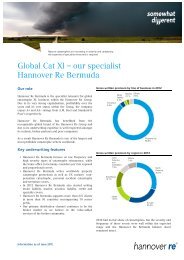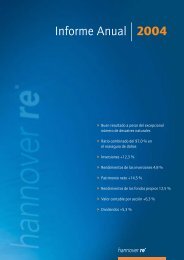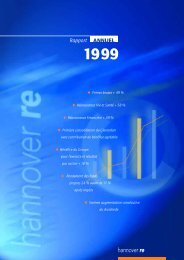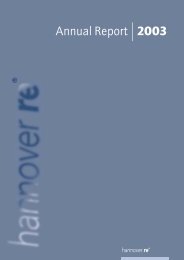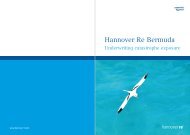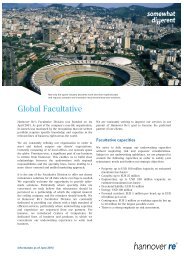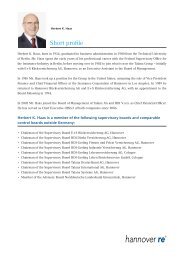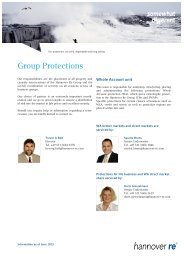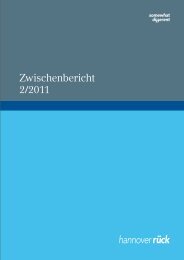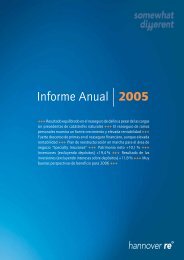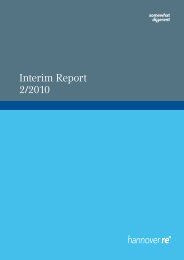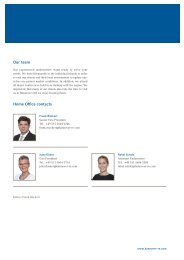Annual Report 2010 - Hannover Re
Annual Report 2010 - Hannover Re
Annual Report 2010 - Hannover Re
You also want an ePaper? Increase the reach of your titles
YUMPU automatically turns print PDFs into web optimized ePapers that Google loves.
• <strong><strong>Re</strong>port</strong>ing to the Risk Committee and the Executive Board<br />
that is counterparty-oriented and encompasses all the various<br />
types of risk<br />
• Documentation of the material elements of the system in<br />
mandatory instructions<br />
• Good financial strength and risk management ratings from<br />
the rating agencies of greatest relevance to our company<br />
The current financial strength rating from Standard & Poor’s<br />
is “AA–” (“Very strong”, stable outlook), while the rating from<br />
A.M. Best is “A” (“Excellent”, positive outlook). <strong>Hannover</strong> <strong>Re</strong>’s<br />
risk management is assessed by Standard & Poor’s as “strong”,<br />
the second-best S&P rating. This evaluation testifies to the<br />
quality of our holistic approach to risk management.<br />
Functions within the risk management system<br />
The interplay of the individual functions and bodies within the<br />
overall system is vital to an efficient risk management system.<br />
The roles and responsibilities are clearly defined and ensure<br />
smooth interaction.<br />
Quantitative risk management methods<br />
<strong>Hannover</strong> <strong>Re</strong> has developed an internal capital model for risk<br />
quantification as a central risk management tool. The purpose<br />
of risk quantification inter alia is to assess the capital resources<br />
of the <strong>Hannover</strong> <strong>Re</strong> Group and its individual companies. In addition,<br />
the model is used to establish the risk contribution made<br />
by individual business groups and business segments to the<br />
total company risk as well as the risk-appropriate allocation of<br />
the cost of capital.<br />
Central elements of the risk management system<br />
Body/function<br />
Supervisory Board<br />
Executive Board<br />
Risk Committee<br />
Chief Risk Officer<br />
Group Risk Management<br />
Business units 1<br />
Internal Auditing<br />
Key risk management tasks<br />
• Advising and supervising the Executive Board in its management of the company,<br />
inter alia with respect to risk management, on the basis of the Supervisory<br />
Board‘s Rules of Procedure<br />
• Overall responsibility for Group-wide risk management<br />
• <strong>Re</strong>sponsibility for the proper functioning of risk management<br />
• Definition of the risk strategy<br />
• Appointment of the Chief Risk Officer and the members of the Risk Committee<br />
• <strong>Re</strong>lease and approval of new products and new business areas<br />
Process-integrated monitoring<br />
• Operational risk management, monitoring and coordinating body<br />
• Decision-making power is within the bounds of the risk strategy defined by<br />
the Executive Board<br />
• Implementation and safeguarding of a consistent Group-wide risk management<br />
culture<br />
Process-integrated monitoring<br />
• <strong>Re</strong>sponsibility for holistic risk monitoring across business groups (systematic<br />
identification and assessment, control/monitoring and reporting) of all<br />
material assets- and liabilities-side risks from the Group perspective<br />
Process-integrated monitoring<br />
• Holistic risk monitoring across business groups (identification, assessment,<br />
monitoring and reporting of all material assets- and liabilities-side risks from<br />
the company perspective)<br />
• Methodological expertise in the development of processes and methods for<br />
risk analysis, assessment and management as well as for risk limitation and<br />
reporting<br />
Process-integrated controlling<br />
• Primary responsibility for risk identification and assessment on the departmental<br />
level based on the guidelines of Group Risk Management<br />
• Setting up and monitoring of the department‘s internal control system (ICS)<br />
Process-independent monitoring<br />
• Process-independent and Group-wide supervision on behalf of the Executive<br />
Board<br />
• The key aspects of the auditing tasks performed by the internal auditing<br />
function are based upon the Rules of Procedure and department strategy<br />
approved by the Executive Board<br />
1 Treaty departments and service departments in the non-life and life/health reinsurance business groups as well as the investments sector<br />
56 Management report opportunity and risk report<br />
<strong>Hannover</strong> <strong>Re</strong> Group annual report <strong>2010</strong>



